To the readers in Japan, it suddenly got so much cooler today, and outside must seem thoroughly auturmn-like.
The top temperature of the day last week is 10C higher than today's sounds rather crazy!
This never happens in Thailand as it is always summer throughout a year.
To the readers in West Europe, the weather skipped to autumn and it's gone into a winter now, I heard.
Around Vancouver in Canada, one of my friends wrote to me and it sounds similar to the one in Europe.
We are heading towards autumn and eventually winter in the countries in the Norther Hemisphere.
Before autumn comes thoroughly, please allow me to write on "Fireworks" continued from the last post.

There are a few songs of Fujifabric's being inspired by fireworks, and "Sparklers" (Senkou-Hanabi) is one of them.
It is the first song in the Mini-Album called "A la Carte" released on the 21st October 2002, and it enjoyed its unique distinctive atmosphere.
Please find the part, "If have a time to savour the feeling of solitude" in lyrics. (The English lyrics of this song is not yet finished... Sorry about that! I am going to work on it soon.)
Have you ever played a sparkler before?
Japanese Sparkler called "Senkou-Hanabi" is quite different to the one played in UK on Guy Fawkes Night.
Senkou-Hanabi is one of the classic hand-held fireworks that burns slowly while emitting reddish yellow flames and sparks.
It has been love by Japanese people over 300 years, but it is such a shame that there are only three firework artisans left who produce this type of fireworks in Japan now.
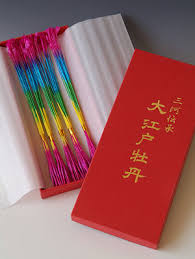
Senkou-Hanabi consists of a thin shaft of twisted tissue paper about 20 centimeters long with one end containing a few grains of a black gunpowder.
The type called Nagate (literally meaning "long hand") common in the East part of Japan are handmade because the process of packing several different composition into a piece of paper tube and twisting skilfully can be done only by human hands with a great experience.
Therefore, a great amount cannot be manufactured by a machine in a factory.
As the labour cost is so high in Japan that most of this type of fireworks are made and imported from China nowadays.
There are 4 stages while Senkou-Hanabi is ignited ;
1. Stage of Peony - a molten slag is formed
2. Stage of Pine Needle - spraying an array of delicate branching sparks
3. Stage of Willow - sparks are lowered down
4. Stage of Fluttering Chrysanthemum - just before burning out
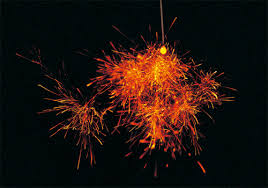
In my hometown, Yamanashi Prefecture, my grandparents called this fireworks as "Rose Moss".
The shape of the sparks looks similar to the leaves of rose moss, too, though...
You look for a place where no wind blowing first, and squat down.
Hold the thin tissue paper end up, the pointed end straight down.
Light the pointed end so that the flame is at the bottom.
After a few seconds, the part in flame rolls up and a glowing molten slag (approx. 3mm diameter) will form. (Stage 1 - Peony)
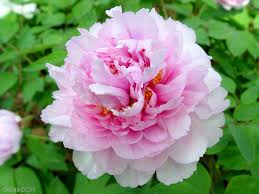
The molten ball spray an array of delicate branching sparks, looking like a bundle of pine needles, with a range of up to 20 cm. (Stage 2 - Pine Needle)

After probably 30 seconds or less, the branching sparks start lowering down and the molten ball gets smaller. (Stage 3 - Willow)
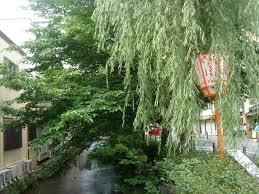
At the end, the branching sparks disappear and the molten ball is surrounded by the thin curved lines looking like falling chrysanthemum petals. (Stage 4 - Fluttering Chrysanthemum)
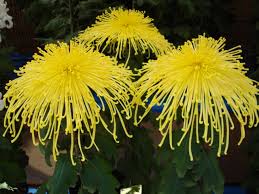
We can feel the Japanese sense of beauty finding each stage is expressed in the name of plants.
When I was little, on a summer night, children gathered and had a competition "whose Senkou-Hanabi can last the longest".
You have to keep the firework away from the wind and hold with a steady hand, so that the delicate molten head does not drop.
If the molten ball is dropped in Stage 2, then your firework will burn out quickly!
It is also a good memory of mine that adults had to give us warning every time when playing Senkou-Hanabi saying, "Don't wear sandals as if a hot molten ball drops on your foot, you will have a serious burn forming a little hole on your foot!"
It is said that it somehow mesmerizes the players into silence and evokes mono no aware (translated as "an empathy toward things," or "a sensitivity to ephemera").
The sparkling bright fireworks are all finished and the fun time is almost over...
Japanese have a special affection towards the things reminding us the beauty and briefness of life (see this Post)
The ephemeral, which has stayed with us over thousand of years, is still felt in the celebration of Senko-Hanabi.
Mr. Shimura in Fujifabric, who was such a wonderful artist, must have felt the poignantly briefness of life even more than us...
But we feel the same in you, Mr. Shimura...
You make us feel ephemeral of life, you know...
Fireworks must occupy some spaces in his heart for definite when remembered those summer days with his family, friends and a girlfriend.
Please share the feeling of ephemeral with us through fireworks.
"Senkou-Hanabi" by Fujifabric
The top temperature of the day last week is 10C higher than today's sounds rather crazy!
This never happens in Thailand as it is always summer throughout a year.
To the readers in West Europe, the weather skipped to autumn and it's gone into a winter now, I heard.
Around Vancouver in Canada, one of my friends wrote to me and it sounds similar to the one in Europe.
We are heading towards autumn and eventually winter in the countries in the Norther Hemisphere.
Before autumn comes thoroughly, please allow me to write on "Fireworks" continued from the last post.
There are a few songs of Fujifabric's being inspired by fireworks, and "Sparklers" (Senkou-Hanabi) is one of them.
It is the first song in the Mini-Album called "A la Carte" released on the 21st October 2002, and it enjoyed its unique distinctive atmosphere.
Please find the part, "If have a time to savour the feeling of solitude" in lyrics. (The English lyrics of this song is not yet finished... Sorry about that! I am going to work on it soon.)
Have you ever played a sparkler before?
Japanese Sparkler called "Senkou-Hanabi" is quite different to the one played in UK on Guy Fawkes Night.
Senkou-Hanabi is one of the classic hand-held fireworks that burns slowly while emitting reddish yellow flames and sparks.
It has been love by Japanese people over 300 years, but it is such a shame that there are only three firework artisans left who produce this type of fireworks in Japan now.
Senkou-Hanabi consists of a thin shaft of twisted tissue paper about 20 centimeters long with one end containing a few grains of a black gunpowder.
The type called Nagate (literally meaning "long hand") common in the East part of Japan are handmade because the process of packing several different composition into a piece of paper tube and twisting skilfully can be done only by human hands with a great experience.
Therefore, a great amount cannot be manufactured by a machine in a factory.
As the labour cost is so high in Japan that most of this type of fireworks are made and imported from China nowadays.
There are 4 stages while Senkou-Hanabi is ignited ;
1. Stage of Peony - a molten slag is formed
2. Stage of Pine Needle - spraying an array of delicate branching sparks
3. Stage of Willow - sparks are lowered down
4. Stage of Fluttering Chrysanthemum - just before burning out
In my hometown, Yamanashi Prefecture, my grandparents called this fireworks as "Rose Moss".
The shape of the sparks looks similar to the leaves of rose moss, too, though...
You look for a place where no wind blowing first, and squat down.
Hold the thin tissue paper end up, the pointed end straight down.
Light the pointed end so that the flame is at the bottom.
After a few seconds, the part in flame rolls up and a glowing molten slag (approx. 3mm diameter) will form. (Stage 1 - Peony)
The molten ball spray an array of delicate branching sparks, looking like a bundle of pine needles, with a range of up to 20 cm. (Stage 2 - Pine Needle)
After probably 30 seconds or less, the branching sparks start lowering down and the molten ball gets smaller. (Stage 3 - Willow)
At the end, the branching sparks disappear and the molten ball is surrounded by the thin curved lines looking like falling chrysanthemum petals. (Stage 4 - Fluttering Chrysanthemum)
We can feel the Japanese sense of beauty finding each stage is expressed in the name of plants.
When I was little, on a summer night, children gathered and had a competition "whose Senkou-Hanabi can last the longest".
You have to keep the firework away from the wind and hold with a steady hand, so that the delicate molten head does not drop.
If the molten ball is dropped in Stage 2, then your firework will burn out quickly!
It is also a good memory of mine that adults had to give us warning every time when playing Senkou-Hanabi saying, "Don't wear sandals as if a hot molten ball drops on your foot, you will have a serious burn forming a little hole on your foot!"
It is said that it somehow mesmerizes the players into silence and evokes mono no aware (translated as "an empathy toward things," or "a sensitivity to ephemera").
The sparkling bright fireworks are all finished and the fun time is almost over...
Senkou-Hanabi is the one played last amongst other fireworks with complete silence.
Japanese have a special affection towards the things reminding us the beauty and briefness of life (see this Post)
The ephemeral, which has stayed with us over thousand of years, is still felt in the celebration of Senko-Hanabi.
Mr. Shimura in Fujifabric, who was such a wonderful artist, must have felt the poignantly briefness of life even more than us...
But we feel the same in you, Mr. Shimura...
You make us feel ephemeral of life, you know...
Fireworks must occupy some spaces in his heart for definite when remembered those summer days with his family, friends and a girlfriend.
Please share the feeling of ephemeral with us through fireworks.
"Senkou-Hanabi" by Fujifabric

No comments:
Post a Comment